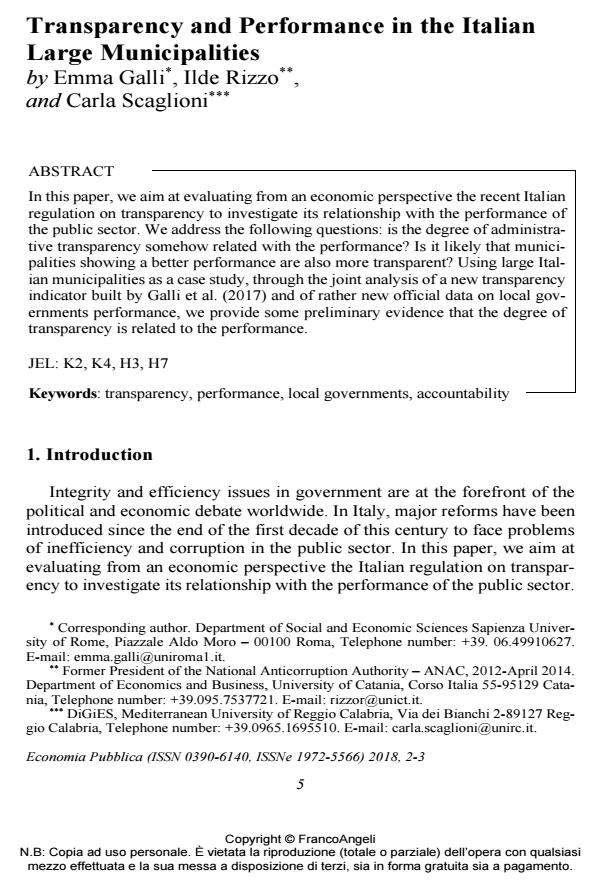Transparency and Performance in the Italian Large Municipalities
Titolo Rivista ECONOMIA PUBBLICA
Autori/Curatori Emma Galli, Ilde Rizzo, Carla Scaglioni
Anno di pubblicazione 2018 Fascicolo 2018/2-3
Lingua Inglese Numero pagine 21 P. 5-25 Dimensione file 233 KB
DOI 10.3280/EP2018-002001
Il DOI è il codice a barre della proprietà intellettuale: per saperne di più
clicca qui
Qui sotto puoi vedere in anteprima la prima pagina di questo articolo.
Se questo articolo ti interessa, lo puoi acquistare (e scaricare in formato pdf) seguendo le facili indicazioni per acquistare il download credit. Acquista Download Credits per scaricare questo Articolo in formato PDF

FrancoAngeli è membro della Publishers International Linking Association, Inc (PILA)associazione indipendente e non profit per facilitare (attraverso i servizi tecnologici implementati da CrossRef.org) l’accesso degli studiosi ai contenuti digitali nelle pubblicazioni professionali e scientifiche
In this paper, we aim at evaluating from an economic perspective the recent Italian regulation on transparency to investigate its relationship with the performance of the public sector. We address the following questions: is the degree of administrative transparency somehow related with the performance? Is it likely that municipalities showing a better performance are also more transparent? Using large Italian municipalities as a case study, through the joint analysis of a new transparency indicator built by Galli et al. (2017) and of rather new official data on local governments performance, we provide some preliminary evidence that the degree of transparency is related to the performance.
Parole chiave:Transparency, performance, local governments, accountability
Jel codes:K2, K4, H3, H7
- A new index of transparency: Evidence for the Italian municipalities Leonardo Salvatore Alaimo, Emma Galli, Ilde Rizzo, Carla Scaglioni, in Socio-Economic Planning Sciences 101678/2023 pp.101678
DOI: 10.1016/j.seps.2023.101678 - New Perspectives in the Public and Cultural Sectors Emma Galli, Carla Scaglioni, pp.301 (ISBN:978-3-031-81891-2)
- Is transparency spatially determined? An empirical test for Italian municipalities Emma Galli, Ilde Rizzo, Carla Scaglioni, in Applied Economics /2020 pp.6372
DOI: 10.1080/00036846.2020.1795068 - La qualità del contesto istituzionale: come varia tra le regioni e nel tempo (The Quality of the Institutional Context: How it Varies Across Regions and Over Time) Mario Cannella, Marco Mancinelli, Sauro Mocetti, in SSRN Electronic Journal /2025
DOI: 10.2139/ssrn.5409302
Emma Galli, Ilde Rizzo, Carla Scaglioni, Transparency and Performance in the Italian Large Municipalities in "ECONOMIA PUBBLICA " 2-3/2018, pp 5-25, DOI: 10.3280/EP2018-002001